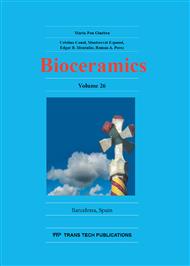p.61
p.67
p.73
p.78
p.83
p.88
p.93
p.99
p.107
Calcium Phosphate-Loaded Strips, Plugs and Putties: Physico-Chemical Properties for Osteopromotion and Ease of Surgery
Abstract:
The present study focuses on the physico-chemical and structural properties of composite scaffolds composed of biopolymer matrices (collagen or polysaccharide) loaded with calcium phosphate granules. A systematic three-dimensional analysis method was used to quantitatively characterize a series of plugs, strips and putties in terms of percentage of inorganic filler particles, size of the loaded granules, and spatial homogeneity of the calcium phosphate granules distribution. It appears clearly that each biomaterial currently available on the market offers specific properties. As a consequence, surgeons have to choose the medical device that best suits their needs depending on the clinical constraints but also should be aware of the mineral properties which remains key to bone reconstruction.
Info:
Periodical:
Pages:
83-87
Citation:
Online since:
November 2014
Authors:
Keywords:
Price:
Сopyright:
© 2015 Trans Tech Publications Ltd. All Rights Reserved
Share:
Citation:


